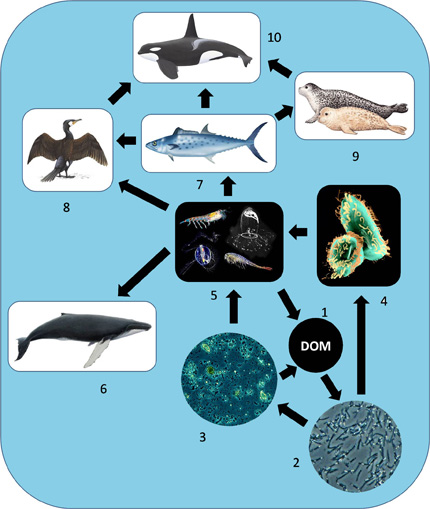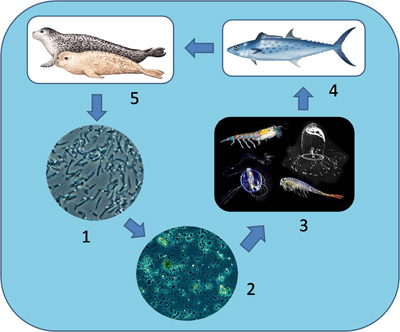2. Ecosystems (3/6)
Food-chains
At the basis of all marine food chain is formed by small plants (algae), when floating freely in the water collumn they are called phytoplankton and when attached to the sea floor or rocks they are called the phytobenthos. With ocean colour remote sensing we mainly study the floating plants: the phytoplankton.
There are two basic reasons why phytoplankton is so important for life in the sea:
1. They photosynthesize oxygen and released it to the sea around them, this is essential for all marine fauna.
2. These plants provide the food (organic material) for higher life forms in the food chain.
Two examples of a simple food-chain, one palagic and one benthic in the the coastal seas, are provided in the following figures:
The coral reefs are very special coastal ecosystems. These are systems with a very large biodiversity. Also the pelagic and benthic food chains are coupled in multiple ways. You can learn more about coral reefs in the tutorial Coral Reefs
Microbal Loop
The plankton is consumed by small animals (the zooplankton), which in its turn are eaten by small fish. Larger predators, like big fish, seals and birds are on top of the food chain, together with humans. This linear arrangement of predation was the classical picture of ocean food chains until the 1970s.
Then, marine biologists began to discover that most photosynthesis and respiration
in the ocean was by micro-organisms less than 20 micrometers in size, rather
than larger phytoplankton and animals. These micro-organisms compose the microbial loop,
which includes bacteria, viruses, protozoa, and small phytoplankton. The simple food
chain that progresses from one trophic level to another has been replaced by a more
complex food web, which includes the microbial loop.

Marine food web with the classical food chain of phytoplankton, zooplankton, fish, and whales. Note that humpback whales are baleen whales, which strain plankton through their baleen (number 6). Seals and birds breathe air as do whales. The microbial loop [dissolved organic matter (DOM), bacteria, and protozoa] is the most recently discovered part of the marine food web. (Photographs are courtesy of the National Oceanic and Atmospheric Administration/Department of Commerce and the Bigelow Laboratory for Ocean Sciences.)
All living plants and animals die after some time. A special role in the food chain is played by the fungi and bacteria, which decompose the living organisms to basic minerals. These minerals might again provide the building blocks of photosynthesis by phytoplankton.


